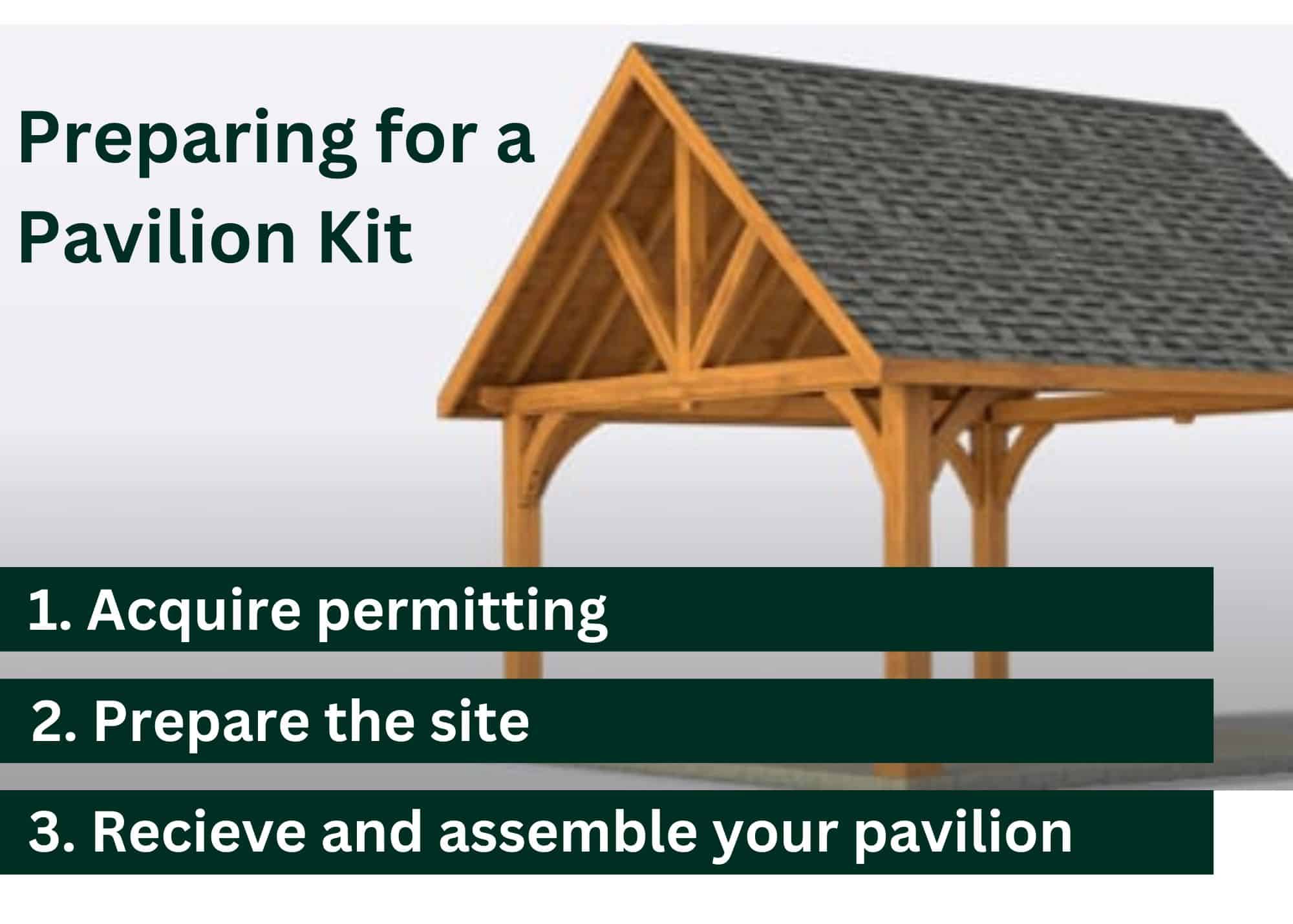The Simple Guide To Pavilion Kits
Have you ever considered putting a pavilion in your backyard but felt intimidated by the thought of building it yourself?
Of course, you could hire a pro, but maybe you don't want the expense and bother.
If that sounds like you, maybe you should consider a pavilion kit.
At Fisher’s Backyard Structures, we make pavilion kits as an easy way for homeowners to add a high-quality pavilion to their backyard.
In this article, we will discuss the pros and cons of pavilion kits, materials and sizing, prepping your ground for construction, and more!
What Is A Pavilion Kit?
A pavilion kit is as simple as it sounds. It’s a kit that includes everything you need to assemble a pavilion, with all parts ready-made. The kit includes pieces cut to size with pre-drilled holes and all the necessary hardware. All you need is a few common tools and the manpower to assemble the kit.
Because everything is precisely made and ready to assemble, you save time cutting, drilling, and reworking pieces that don’t fit perfectly. Assembly should be quick and easy!
Can you assemble a pavilion kit yourself?
Yes! If you have some experience with tools and the manpower to get the job done, you can buy a kit and assemble it yourself. That is one of the benefits of buying a ready-to-assemble kit.
Of course, if you don’t have the experience to assemble it yourself, you can always have a pro do it.
Benefits Of Buying A Pavilion Kit
So why would you buy a kit instead of constructing a pavilion from scratch or transporting one already assembled?
There are multiple good reasons to go for a kit. Here are a few benefits you could gain:
-
You have the option of assembling your kit yourself
Handy homeowners may want to skip having a work crew around the place and opt for assembling their pavilion themselves. With an easy-to-assemble kit, this shouldn’t be too difficult for someone with some construction experience and adequate manpower.
-
You can make minor adjustments to the positioning during construction
If you buy a pre-assembled pavilion and have it transported to your property, it’s pretty hard to move it once it’s positioned. When you assemble your pavilion on site, you have the option of making small adjustments during construction.
-
You won’t have the hassle of having an assembled pavilion delivered
Delivering a pre-assembled pavilion could be a complicated operation requiring some big equipment! And building a pavilion from scratch requires days of cutting, drilling, and assembling and will likely result in sawdust, wood pieces, tools, and people all over your yard. You will likely have a mess on your hands afterward.
On the other hand, assembling a pavilion kit only requires a few simple tools and can be done in a single day. You can skip the hassle of big equipment on your property or a crew working for a long period of time.
-
You may save money on labor costs
Cutting down construction time means cutting down on labor costs, especially if you assemble your kit yourself.
-
Construction time is shorter
Building a pavilion from scratch is an involved process that takes a long time and may result in an extensive mess of wood scraps, sawdust, misplaced screws, and human footprints all over your property.
You can avoid all that hassle and mess with an easy-to-assemble pavilion kit!

Pavilion Kit Materials/Sizing
When thinking about a “kit,” some people get scared because they think anything that comes in a kit will be generic, and they won’t get to customize their structure.
However, most times, you’ll be able to customize at least some aspects of your pavilion, specifically stain, roofing materials, and sizing. In this section, we’ll look at some of the options you may have.
Materials
You have several options when it comes to pavilion materials. A few of the most common options include:
- Wood
Wood is a common choice for pavilions. Wood pavilions are affordable, easy to assemble, and beautiful, but the downside is that they normally require some ongoing maintenance. Pressure-treated yellow pine and red cedar are common wood choices for outdoor structures.
- Timber frame
Timber frame pavilions are made of wood usually Douglas Fir, but the timber framing construction process is slightly different than conventional wood pavilions. Timber framing results in a strong, majestic pavilion. Timber frame pavilion kits have endless custom options and features available.
- Vinyl
Vinyl structures are normally a little more expensive than wood structures but don’t require ongoing maintenance. This makes them a good choice for homeowners who don’t want to spend time painting or staining their pavilion every year.
- Roof materials
The two most common roofing materials for pavilions are asphalt shingles and metal roofing.
Sizing
Once you receive your pavilion, you cannot change the size! That means you want to be sure you know what size you want before you order your kit.

There are multiple factors that come into play when you decide what size your pavilion should be.
For instance:
- What is the purpose of your pavilion? Do you envision using it for quiet evenings with your immediate family? Or do you want to go big and host weddings and events?
- What’s your budget? The larger your pavilion, the more costly it will be.
- How much available space do you have for a pavilion?
You’ll need to consider these and other factors when deciding the right pavilion size. The best way to determine sizing is to get out there and take some real measurements.
Get a tape measure out and assess your available space and what you want to do with your pavilion. You may even want to arrange some furniture in a mock-up to get an idea of what fits in certain dimensions.
Preparing For A Pavilion Kit
So you’ve decided you need a pavilion, customized your kit, and purchased it.
What now?
How should you get ready to install your pavilion kit once it arrives?
Acquire permitting
Step one is ensuring you have the proper permits to install a pavilion. Depending on your municipality, there may be building codes and requirements concerning the size of structures you can build on your property and the distance they need to be from the road.
Some areas also have HOAs (homeowners associations) with rules and regulations regarding what you can build on your property.
We highly encourage you to check out these codes and ensure your plans are up to code.
You could do this yourself, or if it looks confusing, look to a local contractor to do it for you.
Prepare a site
Pavilions need to be installed on either a concrete slab foundation or continuous post footings that anchor the structure. Most can be successfully anchored to a reinforced concrete slab at least 4” in thickness, with an additional depth of 12” total on the outside edge.
You’ll need to pour a foundation in enough time to allow the concrete to properly cure before the arrival of your pavilion.
Hiring a local contractor to prep your site may be wise, as it is an involved process.
Receive and assemble your pavilion!
Once you have your permits and your site prepped, it’s time to receive and assemble your pavilion. After that, you’ll get to enjoy it for years to come.
Bonus: For best results, keep on top of pavilion maintenance!

Conclusion
A pavilion is an investment you’ll enjoy for years to come, and the work it initially costs normally pays off big in the end!
We hope this article helps get you on your way to a gorgeous space of outdoor rest and relaxation.
If you want to look at pavilion kits today, check out the Fisher’s Backyard Structures website!
We offer wood, vinyl, and timber frame pavilion kits, as well as other backyard structures, including pergolas and gazebos!
It’s easy to work with us:
- Design your structure online
- Receive a quote
- Schedule and install
- Love your new space!
Visit our website or contact us today for more information!




